
Hidden within the intricate patterns of nature lies a fascinating world where art and science collide. Fractals, the infinitely complex patterns that are self-similar across different scales, are more than just mathematical curiosities. They offer a lens through which we can explore the interconnectedness of different disciplines. But what makes these geometrical wonders so compelling, and how have they bridged the gap between art, science, and philosophy?
Early Influences: A Seed of Curiosity
In the earlier days of mathematical exploration, fractals were merely intriguing shapes formed by mathematical equations. However, as time goes on, these shapes began to reveal hidden connections across various fields. Pioneers like Benoît Mandelbrot, who coined the term ‘fractal’ in 1975, saw beyond their abstract beauty, envisioning a world where these patterns extended to nature and art.
- Fractals first appeared in mathematical discussions in the 17th century.
- Benoît Mandelbrot, born 1924 in Poland, became a pivotal figure in fractal geometry.
Interestingly, it was Mandelbrot’s ability to see patterns in financial markets, coastlines, and even art that propelled fractals into the limelight. His work demonstrated that these shapes were not just mathematical oddities but mirrors reflecting the complexity of life and creativity.
Mental Models: Seeing Beyond the Math
For those who see the world through the lens of fractals, it’s like peering into a universe where order and chaos dance in perfect harmony. Mandelbrot’s mental model allowed him to see the world as a tapestry woven through repeating patterns, which, when magnified, revealed more detail.
- Mandelbrot’s vision was informed by diverse disciplines, including linguistics and economics.
- He believed that fractals offered a new way to understand natural phenomena.
Of course, not everyone could immediately grasp the significance of these patterns. Many people believe that the beauty of fractals lies in their ability to explain nature’s complexity simply. Mandelbrot’s work helped others to visualize a world where structure and beauty are not opposing forces but complementary aspects of a greater whole.
Challenges & Resilience: The Road Less Traveled
Introducing fractals into the mainstream was no easy feat. The scientific community, ever skeptical, initially dismissed them as mere mathematical novelties. But Mandelbrot’s resilience and dedication paid off as he persevered in demonstrating their real-world applications.
- Fractals faced initial skepticism from the scientific establishment.
- They later gained recognition for their applicability in diverse fields.
No wonder, then, that the art world soon took notice. Artists began to see fractals as a source of inspiration, transforming mathematical formulas into stunning visual artwork. This cross-pollination further fueled the acceptance of fractals as a legitimate scientific and artistic concept.
Legacy: A Lasting Impact on Art and Science
Today, the legacy of fractals extends beyond mere scientific curiosity; they have become a symbol of interconnectedness across disciplines. Their influence can be seen in everything from computer graphics to environmental modeling, as well as in contemporary art.
- Fractals have influenced computer graphics, leading to realistic visual effects.
- They continue to inspire artists and scientists alike.
As fractals weave their way into the fabric of modern culture, they remind us that the beauty of structure is a universal language. Their enduring appeal lies in their ability to make us question and reexamine our understanding of the world, blending the lines between art, science, and philosophy.
In conclusion, the exploration of fractals reveals a hidden connection that binds the aesthetic and the analytical, offering a deeper understanding of the world. By recognizing the structure within beauty, we find a common thread linking disciplines that once seemed disparate.
Fuel Someone Else’s Curiosity
Why keep such fascinating connections to yourself? Share this article with others and spark a conversation about the wonders of fractals. Whether you’re an artist, scientist, or philosopher, the beauty of fractals is something everyone can appreciate. Let’s inspire each other to see the world through the eyes of Mandelbrot and discover the intricate patterns of life together.

Leave a Reply